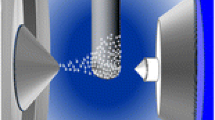Abstract
A simple method is proposed for analysis of stimulant laxatives and metabolites of laxatives in urine. All stimulant laxatives commercially available in Germany, Begium and the Netherlands, the diphenylmethane derivatives and the anthraquinones, were included. Chromatography was performed with a standardized isocratic HPLC system with diode array detection ('STIP'), which is commonly used in the Netherlands for toxicological screening. The method was validated by ingestion of a normal dose of the laxatives by human volunteers. In all cases the expected laxative metabolite could be detected in urine twelve hours after intake. Also urine samples of patients, suspected of laxative abuse, were analyzed.
Similar content being viewed by others
References
Donowitz M. Magnesium-induced diarrhea and new insights into the pathobiology of diarrhea [editoral]. N Engl J Med 1991;324(15):1059-60.
Perkins SL, Livesey JF. A rapid high-performance thin-layer chromatographic urine screen for laxative abuse. Clin Biochem 1993;26(3):179-81.
De Wolff FA, de Haas EJM, Verwey M. A screening method for establishing laxatives abuse. Clin Chem 1981;27(6): 914-7.
Duncan A, Cameron A, Stewart MJ, Russell RI. Diagnosis of the abuse of magnesium and stimulant laxatives. Ann Clin Biochem 1991;28(6):568-73.
Morton J. The detection of laxative abuse. Ann Clin Biochem 1987;24(1):107-8.
Kok RM, Faber DB. Qualitative and quantitative analysis of some synthetic chemically acting laxatives in urine by gaschromatography-mass spectrometry. J Chromatogr 1981; 222:389-98.
Fullinfaw RO, Bury RW, Moulds RFW. Screening procedure for stimulant laxatives in urine using high-performance liquid chromatography with diode array detection. J Chromatogr 1988;433:131-40.
Phillips S, Donaldson L, Geisler K, Pera A, Kochar R. Stool composition in factitial diarrhea: a 6-year experience with stool analysis. Ann Intern Med 1995;123:97-100.
Snoeren RA, Duchateau AMJA, Conemans JMH, Gerkens FDA, Pijnenburg CC, Barella CGJ, et al. Systematic toxicological analysis of drugs with HPLC and diode array detection. (Abstract) Pharm Weekbl (Sci) 1989;11(3):E16.
Pijnenburg CC, Duchateau AMJA, Conemans JMH, Gerkens FDA, Snoeren RA, Barella CGJ, et al. Systematische toxicologische analyse van geneesmiddelen met behulp van HPLC en UV-detectie. Ziekenhuisfarmacie 1990;6(1):1-4.
Jauch R, Hankwitz R, Beschke K, Pelzer H. Bis-(p-hydroxyphenyl)-pyridyl-2-methane: the common laxative principle of bisacodyl and sodium picosulfate. Arzneim Forsch 1975;25(11):1796-800.
Rights and permissions
About this article
Cite this article
Stolk, L., Hoogtanders, K. Detection of laxative abuse by urine analysis with HPLC and diode array detection. Pharm World Sci 21, 40–43 (1999). https://doi.org/10.1023/A:1008647424809
Issue Date:
DOI: https://doi.org/10.1023/A:1008647424809




